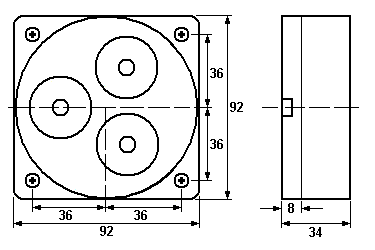

For example, active current consumption is just 300μA in 1x mode, with an input voltage of 3V, input frequency of 4kHz and driving a 15nF piezo.
#PIEZO SOUNDER VOLUME DRIVER#
The sounder driver helps to keep current consumption low and battery life long by employing built-in automatic shutdown and wake-up functions. The charge pump also enables designers to select three different piezo sound pressure levels by offering 1x, 2x and 3x operating modes. Operating from a 2.3V to 5.5V supply at a fixed frequency of 1MHz, the PAM8904 is able to drive a sounder load of up to 15nF, providing a 9V output with a minimal component footprint. With its wide input signal range of 20Hz to 300kHz and ability to deliver high volume at a low operating current, this driver is suitable for a variety of battery-powered applications, including medical systems, alarm clocks and security devices. The PAM8904 is capable of driving piezoelectric sounders up to 18VPP from a 3V power supply. R2 can probably be a lot lower, but again, you didn't supply a datasheet so all the component values are just rough ideas or guesses at best.Diodes Incorporated (Nasdaq: DIOD), a leading global manufacturer and supplier of high-quality application specific standard products within the broad discrete, logic and analog semiconductor markets, today introduced the PAM8904 piezo-sounder driver with integrated multi-mode charge pump boost converter. R2 cause some back voltage to this current to make it die down more quickly, helping the high frequecy response. If you don't give the kickback current a place to go, then the voltage can get high enough to fry Q1. Piezo elements have a significant inductive component as viewed from the driving circuit. Figure you can count on a gain of 50, so that means 215 mA of collector current, which should be way more than required.ĭ1 is there to give the kickback current of SP1 a place to go when Q1 turns off suddenly. When the digital output is high, Q1 will have 4.3 mA of base current, which should easily give it enough current sink capability to pull the collector as low as it can go. You most likely don't need as much base drive as this. Most digital outputs can source that much without issue. Figure the B-E junction drops 700 mV, so that leaves 4.3 V accross R1, which causes 4.3 mA base current and will draw that much from the digital output. R1 limits the current thru the base of Q1 when the digital output is high. The above circuit should work well enough for most piezo speakers, although it can possibly be driven from a higher voltage, which would yield higher volume. The page you linked to turned out not to be a datasheet, so we don't know anything more about the piezo speaker than what you say.

You said you were a novice, so here is something simple: Is this correct? Is it possible to build a drive circuit for a piezo buzzer with only these components, or do I something else? The supplementary comments for this circuit diagram suggested people "consider connecting a Zener diode in parallel with the piezoelectric sound component and Rp if necessary."īased on this, my understanding is that the necessary components of this drive circuit are - the microcomputer, I am a novice with electrical engineering and I am trying to understand exactly what components are needed in this external drive piezo buzzer drive circuit. Under the heading "Please give me an example of the drive circuit for a Piezoelectric Sounder or a Piezoelectric Diaphragm (External Drive Type)." they said "Examples of typical drive circuits are broadly divided into case 1 where a transistor circuit is used and case 2 where the product is driven directly from a microcomputer." and gave the following image as an example. I was reading the FAQ page on the website of a piezo buzzer manufacturer I am interested in the use of a microcomputer in a drive circuit for an external drive piezo buzzer.


 0 kommentar(er)
0 kommentar(er)
